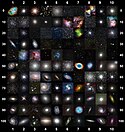M24 - VST - potw2237a
Wispy dark clouds
The dark clouds in this image, taken from ESO’s Paranal Observatory in Chile, almost resemble something supernatural, like the wispy trails of ghosts in the sky. But there is no need to call the ghostbusters! These clouds, known as Barnard 92 (right) and Barnard 93 (left) are dark nebulae: they look pitch black because the dense gas and dust they contain block out the background light, creating these hazy ghostlike features.
These nebulae are stellar nurseries, where new stars are born out of the collapsing dense gas and dust. This whole region of space imaged here is actually part of a much larger stellar complex, called the Small Sagittarius Star Cloud (or Messier 24, catalogued by Charles Messier in 1764). This area is so rich in stars that it is clearly visible to the naked eye during dark nights, in the constellation of Sagittarius.
This image was taken with an enormous 268 million pixel camera called OmegaCAM on the VLT Survey Telescope. OmegaCAM is designed for capturing wide fields like this image, where you could impressively fit four full Moons. This image is part of the VST Photometric Hα Survey of the Southern Galactic Plane and Bulge (VPHAS+), which has mapped diffuse nebulae as well as both young and evolved stars in our galaxy.
Credit:
ESO/VPHAS+ team. Acknowledgement: Cambridge Astronomical Survey Unit
Coordinates Position (RA): 18 15 37.20 Position (Dec): -18° 10' 25.21" Field of view: 6.00 x 6.00 arcminutes Orientation: North is 0.2° right of vertical
Colours & filters Band Telescope Optical g 480 nm VLT Survey Telescope OmegaCAM Optical r 625 nm VLT Survey Telescope OmegaCAM Optical H-alpha 659 nm VLT Survey Telescope OmegaCAM Optical i 770 nm VLT Survey Telescope OmegaCAM.
This media was created by the European Southern Observatory (ESO).
Their website states: "Unless specifically noted, the images, videos, and music distributed on the public ESO website, along with the texts of press releases, announcements, pictures of the week, blog posts and captions, are licensed under a Creative Commons Attribution 4.0 International License, and may on a non-exclusive basis be reproduced without fee provided the credit is clear and visible." To the uploader: You must provide a link (URL) to the original file and the authorship information if available. | |
Diese Datei ist lizenziert unter der Creative-Commons-Lizenz „Namensnennung 4.0 international“.
| |
Relevante Bilder
Relevante Artikel
Messier 24Messier 24 ist ein sichtbarer Teil des Sagittarius-Arms der Milchstraße. Nach dem Aussehen der Sternwolke prägte Angelo Secchi (Vatikansternwarte) um 1850 den Namen Delle Caustiche. Heute wird sie meist Sagittarius-Wolke bzw. kleine Sagittarius-Wolke genannt – zur Abgrenzung von der großen Sagittarius-Wolke, einem sichtbaren Teil des Zentralbereichs der Galaxis etwas weiter südlich. Charles Messier hielt die sehr kompakt erscheinende Wolke 1764 für einen Sternhaufen und nahm sie deshalb in seinen Nebelkatalog auf. .. weiterlesen



